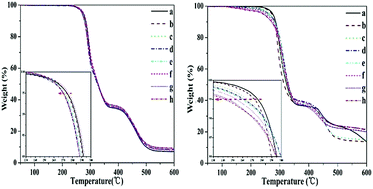Construction of chain segment structure models, and effects on the initial stage of the thermal degradation of poly(vinyl chloride)†
Abstract
The thermal degradation of poly(vinyl chloride) (PVC) is inevitable during its processing and is directly related to the initial stage of the thermal stability of PVC. This paper focuses on the influence of the segment structures that include a conjugated polyene sequence structure and internal allylic chloride structure on the initial stage of the thermal degradation of PVC. The conjugated polyene sequence structure and internal allylic chloride structure were the structural models successfully constructed via thermal and alkali treatment methods through the long chain of PVC directly. Ultraviolet-visible spectroscopy (UV-Vis) was used to analyze the type and content of the conjugated polyene structure. Nuclear magnetic resonance spectroscopy (1H-NMR) was used to determine the variation trend in the content of internal allylic chlorine structures because of the oxygen-containing structure excluded by Fourier-transform infrared spectrometer (FTIR) characterization. The thermal stability of the treated PVC was also determined through thermogravimetric analysis (TGA). The comparison between the two structural models revealed that the internal allylic chloride structure greatly influenced the initial thermal stability as an initiation point in the PVC chain, thereby leading to thermal instability.



 Please wait while we load your content...
Please wait while we load your content...